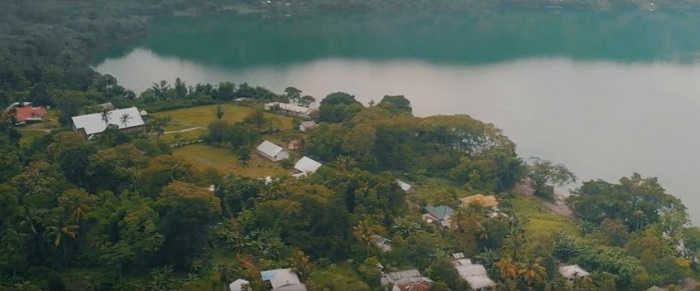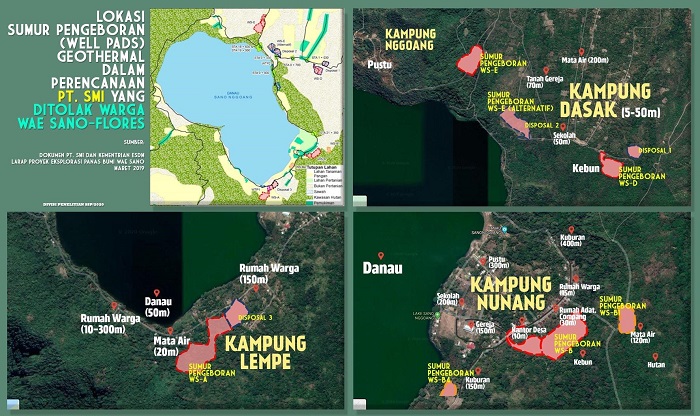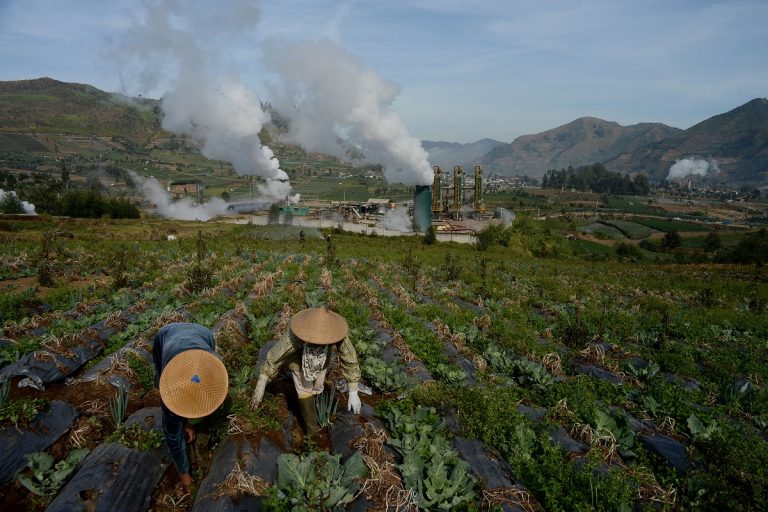Venansius Haryanto
In late January 2021, five people died and dozens were poisoned by noxious hydrogen sulphide (H2S) gases due to an explosion at PT Sorik Merapi geothermal power plant in Mandaling Natal district in North Sumatra province. The incident has amplified the ongoing struggle of an indigenous community at the opposite end of the archipelago, to resist the government’s plan to build the geothermal power plant in their village.
In the wake of the accident in Mandaling Natal, residents of Wae Sano, a community situated at the westernmost part of Flores and part of Sano Nggoang district in Manggarai Barat regency shared links to news reports of the explosion on their Facebook accounts. One community member, Rofinus Rabun, explained in his social media post, ‘this is the reason why I stand my ground to refuse the geothermal project in my village, Wae Sano, up to now. As the accident occurs, the workers would escape and save themselves, while the locals would be left in danger’.
Wae Sano consists of several small villages, Lempe, Nunang, Dasak, Ponceng Kalo and Ta’al. It is a three-hour motorbike ride from Labuan Bajo – the capital of Manggarai Barat. Located on the edge of Sano Nggoang Lake, the villages are nestled in a picturesque setting between the hillside and the lake.
It is not, however, the picture-postcard and tourist-friendly scenery that has attracted government and business interest to the area in recent years. Rather, it is its location precisely at the epicentre of Sano Nggoang Lake – one of the largest volcanic lakes in the eastern part of Indonesia – that has drawn interest for its potential as a significant source of geothermal energy.

Since discussion between government, business and the local community commenced more than two years ago, the people of Wae Sano have consistently resisted the project on the basis that any development should embrace environmental sustainability, local culture and the local economy.
Supporting tourism investment
The development of Wae Sano’s geothermal energy potential is inseparable from the government’s plan to encourage large-scale investments in the tourism sector in Labuan Bajo. For the past decade, the central government has shifted its focus from extractive industries to tourism as the new leading sector of development in Flores, seeing it as a panacea to alleviate poverty on the island. For the last three years, tourism has been intensively encouraged. President Joko Widodo’s government designated Labuan Bajo as one of the priority tourism destinations in Indonesia, popularly known as the ‘10 new Balis’.
To reach that goal, the government rolled out a suite of new regulations. In early 2019, the government issued a President Regulation (Perpres) to change the status of Komodo National Park and the surrounding area, designating it as the so-called National Strategic Territory (Kawasan Strategis Nasional) to be developed as a world-class tourism destination. At the same time, in order to accelerate tourism investment in Flores, the government also established the Tourism Authority Board (Badan Otorita Pariwisata). This institution is specifically responsible for the management of what it termed the Tourism Business Zone of Labuan Bajo-Flores (Kawasan Bisnis Pariwisata Labuan Bajo-Flores), an area comprising over 400 hectares of forest in and around Labuan Bajo. Further, the Ministry of Environment and Forestry granted concessions to private companies and state enterprises covering an area up to 447.17 hectares inside Komodo National Park. Those areas are to be used for construction of exclusive tourism resorts. At the same time, the government will also establish an Exclusive Economic Zone (Kawasan Ekonomi Khusus) covering an area of up to 560 hectares at Golo Mori, close to Wae Sano, east of Komodo National Park.

Positioned within the broader context of this tourism investment in the region, developers clearly deem the geothermal potential of Wae Sano as essential in order to support the increased energy requirements for the project as a whole.
Environmental damage
The people of Wae Sano may not have the ‘scientific’ knowledge to explain the environmental impacts of such a geothermal project, but their experience of living on the shores of Sano Nggoang volcanic lake for centuries means they have a close connection and understanding of its patterns and behaviour. Villagers recount that every year, at a certain time, they experience coughing due to the release of hydrogen sulphide (H2S) gases from the lake. The gas also acts to kill the waterborne organisms in surrounding channels. The people of Wae Sano are fearful that geothermal development on such a scale, involving drilling a two to three kilometre hole deep into the earth, will trigger explosions of H2S gas in higher levels. Against this background, the accident in Mandaling Natal, has amplified their suspicions about the potential negative impact of geothermal development on their own doorstep.
In addition to the incident in Mandaling Natal, the people of Wae Sano have closely followed and learnt from another geothermal project elsewhere on Flores. At Mata Loko, in Kabupaten Ngada, east of Manggarai, the presence of a geothermal project has seen a pattern of environmental damage. Since the project started, rice fields as far as two to three kilometres from the project location, can no longer be used because of the loss of water resource. People living in the surrounding areas are also increasingly affected by respiratory diseases.
Struggling for indigenous values
As in other places around the world, the Wae Sano people, members of the indigenous community of Manggarai, have a unique understanding of their connection to land, which differs from a western capitalist view. The Manggarai indigenous community do not see the value of land in its economic use only, but as having spiritual and ecological meaning also. This view is dismissed - if not silenced and erased— as an important element for consideration in development planning for this area. The main focus is simply on investments.
During one of my visits to Wae Sano in February 2019, Step Abur, a middle-aged man from Wae Sano, explained that he is resisting the geothermal project because he does not want to lose his history and roots as an indigenous person. Beyond their fear of destruction of nature, the geothermal project will have a negative impact on the integrity of their living space as an indigenous community. What they mean by ‘living space’ is the inseparable unity of their village (settlement/golo lonto, dwelling house/mbaru kaeng, playing field/natas labar), livelihood farm (umat duat), water source (wae teku), centre of traditional life (compang takung, mbaru gendang), graves (lepah boak) and forest and lake (puar agu sano). According to the development plans, in Wae Sano, all drilling points will be located precisely within the people’s living space.
In their struggle, the people of Wae Sano consistently identify as an indigenous community, distinguishing their views on development from the government’s version. This was clear, for example, in a letter written by the community in March 2020 to the World Bank, as the funder of the project. They argued that the project does not adhere to the principle of free and prior informed consent, and did not meet local indigenous values.
Embrace community tourism
Since the earliest stages of planning for the geothermal project, Yoseph Erwin, one of the community leaders of Wae Sano, has pointed to the inconsistencies in the government’s own policy and agenda. On the one hand, it sought to encourage tourism, and yet on the other, it was supporting a project that will damage the natural world it seeks to champion.
The people of Wae Sano have expressed their willingness and support for the government to invest in community tourism in their villages. Indeed, tourism is not something new in this region, and locals have received training in this field from various NGOs over the past decades. Organisations like Swiss Contact – an NGO that has long been focusing on developing community tourism in Flores - and Yayasan Burung Indonesia, are among those that have worked with the local community to provide skills training to support local tourism. The people of Wae Sano have built up basic skills and knowledge needed to participate in the tourism sector – all the more reason for their persistence in resisting a geothermal project in their village.
Venansius Haryanto is a researcher at Sunspirit for Justice and Peace, Labuan Bajo, Flores, NTT.
